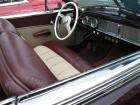|
Re: V-8 head part nbr vs cast nbr
|
||||
|---|---|---|---|---|
|
Forum Ambassador

|
The use of volume and issue numbering for this newsletter dates all the way back to 1927, when it was launched as the Packard Service Letter. While the name changed in the mid-40s to the Packard Service Counselor, volume numbering remained contiguous through 1956.
Not only was did the publishers eliminate dates and volume/issue numbers in this new edition of the reprint, but they renumbered the pages and reindexed the whole thing. That makes for a real PIA when two people are trying to communicate and one has original issues but the other has the new reprint. Yet, previous (comb-bound) editions of the reprints were as originally published by Packard. Stuff like that really makes you wonder what they were thinking. No matter - a solution is on the way. A couple of years ago, I wrote a comprehensive index to all the Service Counselor articles and Service Technical Bulletins, PLUS Studebaker Service Bulletin articles for the V8s, and I am now working with BigKev to take that to a whole new level and extend its functionality to earlier Series. Please stand by by for the premiere of this new feature (hopefully within a week or so). I think you'll find help for a lot of questions that have been asked recently - not just in this thread.
Posted on: 2008/9/17 12:23
|
|||
|
||||
|
Re: 1956 Build Slip Codes
|
||||
|---|---|---|---|---|
|
Just can't stay away
|
Great job Brian, many thanks! On the subject of underseat heaters, I owned an early 56 Caribbean hardtop, 1009, and it had the underseat heater. Someone suggested that only the convertibles had a problem fitting the underseat heater.
Posted on: 2008/9/17 12:19
|
|||
|
||||
|
Re: V-8 head part nbr vs cast nbr
|
||||
|---|---|---|---|---|
|
Home away from home

|
"Unfortunately my Service Counselors are the compendium published by PAC, and they (thoughtlessly) omitted the dates and numbers"
The Vol and No. along with Month and year appears DIRECTLY under the SC letterhead on the 56 SC's. I don't know about the 55 Sc's. So they date and vol. info was DELIBERATLY ommitted.
Posted on: 2008/9/17 12:13
|
|||
|
||||
|
Re: The Second Packard "Twin Six"
|
||||
|---|---|---|---|---|
|
Home away from home
|
Packard53, to try and answer your initial inquiry. I'm not a V-12 expert, but much has been written about the later twelve cylinder engines and the cars they powered. The second generation (1932-1939) V-12s had a unique and interesting valve design. The camshaft and roller tappet/lifter design had the valves sitting relatively high between cylinder banks. The valves intersected the cylinders at an angle that resulted in them being more perpendicular to the cylinders rather than parallel as is typical with a valve-in-block (L-head) design. This coupled with a pent roof piston and flat cylinder head (I believe) resulted in a combustion formed formed by the piston, valves, and a relief in the block and not by a formed chamber in the cylinder head. This design provided for fully machine finished combustion chambers. As far as I know there was no forced induction with these engines. All of this is from my recall, and I may be mistaken in some parts of this description. I also believe that the Auburn V-12 had a unique, but different valve design where the valves were not horizontal with the cylinders. There are many V-12 experts on this site that can quickly correct what I have said.
Posted on: 2008/9/17 11:19
|
|||
|
We move toward
And make happen What occupies our mind... (W. Scherer) |
||||
|
||||
|
Re: V-8 head part nbr vs cast nbr
|
||||
|---|---|---|---|---|
|
Forum Ambassador

|
Unfortunately my Service Counselors are the compendium published by PAC, and they (thoughtlessly) omitted the dates and numbers. But it specifically says its related only to the 320 5540 model engines. I've always assumed, perhaps incorrectly, that it was a manufacturing-driven economy as the machining of the dome couldn't have been an inexpensive operation. The change also corresponded to changes in spark plug specifications, distributor and vacuum advance changes, and carburetor changes, all identified in the same SC. The engine #s that it identifies the changes as occuring at are fairly early in the 55 run, so I don't think it was in anticipation of the 56 engines. I've never seen a 352 or 374 engine with what would appear to be a machined compression dome so perhaps they were cast from the get-go?
Jack, you've seen so many 56 engines, can you verify that last digit on the casting number, "6" or "8"? I've used a magnifying glass and even so, it's pretty hard to be absolutely positive. EDIT: Adding image from SC
Posted on: 2008/9/17 11:01
|
|||
|
||||
|
Re: V-8 head part nbr vs cast nbr
|
||||
|---|---|---|---|---|
|
Home away from home

|
Interesting and arcane info. I've never worked on 320" heads, but by my calculations, they should have 8cc smaller combustion chambers than the '55 352" heads if both have the same 8.5 compression ratio. The Hash engines with the 352" heads on the 320" short block had 7.8 C.R., so that also mathematically checks backward.
Questions: 1. What was the date of the service letter announcing the change from machined to cast combustion chambers? I had assumed the change was made to raise the compression ratio for '56. If so, why was the change made on the 320" engine which never had a published C.R. increase? 2. Did the service letter specifically state the change was only for 320"? All later 352" and 374" had cast chambers, but why would they only announce it for 320"? 3. Was the switch to 2" intakes made at the same time? The specs for all '55s I have seen in print are for the smaller valves, but has anyone ever seen a machined chamber with the larger valves or a cast chamber with the smaller valves? 4. Since '55 352"s had 8.5 C.R and the '56s had 9.55 C.R. (the '56 Hashes got the 9.55 C.R., but still only the two-barrel carburetor.) was the cast chamber phased in at model year change for 352"? thnx, jack vines
Posted on: 2008/9/17 10:43
|
|||
|
||||
|
Re: 1940 110 Compression
|
||||
|---|---|---|---|---|
|
Forum Ambassador

|
I hope you mean .005, .007 etc., not .05, .07 etc. Yeah, setting valves with a hot running engine is no fun at all! But if you can tolerate it, it gives excellent results.
Posted on: 2008/9/17 10:33
|
|||
|
||||
|
Re: 1940 110 Compression
|
||||
|---|---|---|---|---|
|
Home away from home

|
My 38 110 ran very smooth but had low power and a hard hot start issue.Compression was @70 to 75 psi cold.After adjusting the valves -power was much improved and the hard stating was a thing of the past.
The service manual says to set the valves with the engine running and warm to .05 int and .010 exh.I found this almost impossible with the exhaust manifold hot and in the way of the center cylinders.Now I found out you can set them cold to .07 int and .09 exh.Removing the spark plugs, right front wheel and inner fender is a must.I didn't run a second comp test,hind sight indicates I should have. RT
Posted on: 2008/9/17 10:26
|
|||
|
||||
|
Re: Packard run - not quite!
|
||||
|---|---|---|---|---|
|
Quite a regular

|
Hi Ozst...
In answer to your many questions and comments. First of all, I was apparently thrown out of this forum while I was on a trip - came back, asked Bev thru an E mail, got no answer, so I just re-registered under a slightly different name. I am glad you appreciate my intention, which is to sing to the world how marvelous Packard was as an institution, and how marvelous ALL Packards were, regardless of which price class any particular Packard model was in. Obviously, some Packards are bigger, better, faster than others - I have to continually remind people that it is nonsence to accuse the Packard Company of de-frauding its customers, of COURSE the more you paid to Packard, the more car you got. Let's take your situation for example. Packard "120"s were damn good cars. I'll match a "120" series Packard pound for pound, performance for performance, against ANY car in ITS price range. That is...WHEN IT IS FIXED ! FIXED RIGHT ! I am not so sure I accept your story as to why that car of yours is so screwed up. hARD USE DOSNT HURT A PACKARD IF IT IS FIXED RIGHT. My own Packard is coming up on 200,000 HARD miles. When it was in service with its first owner, it was driven hard at high speeds all over the California, Arizona, and Nevada deserts, and when it wasnt doing that, it spent a lot of time in Los Angeles traffic (then, as now, a lot of stop and go). It was left outside on occasion, getting wet. In 1955...it was purchased by a wild and crazy teen-ager, who beat the hell out of it and drove it even faster....( I still do ! ). I re-wired and got re-finished reflectors for it about 30 years ago. Guess what-its headlights are NOT yellow- they are BRIGHT and WHITE. And the lenses of those Flex-Beam headlights it came with when new, are still clear. And be assured then when I am four-wheel drifting it around some of our sorry excuses for roads here in northern Arizona, I dont hear funny noises ...if I did..I'd FIX EM ! Bottom line - that's my message..my relgion...YOU GOT A PACKARD ? FIX IT RIGHT, AND DRIVE THE HELL OUT OF IT WHERE THE PUBLIC CAN SEE IT ! Mine had to be towed ONCE. That was in the summer of '57. Coming up the Cahuenga Pass on an extremely hot day, the $(##(@* vapor-locked. The cops came along with a tow truck and told me they wouldn't wait two minutes...it had to be gotten off the road NOW. Again...towed ONCE. By evening, it had TWO electric fuel pumps. Hasn't been towed since. (actually..there is more to that story of getting vapor-lock and having to be towed, in the Cahuenga Pass that summer of '57....you see..I had this really foxy girl in the car..and she got mad at being stuck...and ditched me...so I didn't get to...hmmm....guess the rest of that story isn't for a technical chat room on Packards.....!)
Posted on: 2008/9/17 9:05
|
|||
|
||||

 (146.42 KB)
(146.42 KB)







